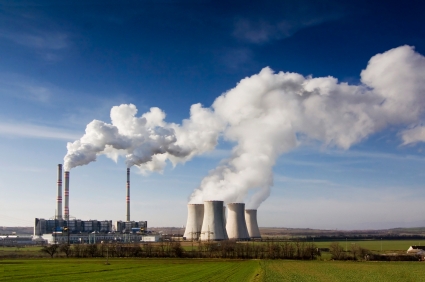After long anticipation and many delays, EPA is expected to issue its first limits on carbon pollution from power plants this week.
With Republicans increasingly desperate in the face of economic recovery, they are sure to treat this as a lifeline, a focus for renewed attacks. They will try to make the rule a stand-in for government overreach, job-killing regulations, and Obama’s secret plan to raise gas prices. Also probably Sharia.
These conservative attacks will be meritless, flying in the face of the considered judgment of credible, independent analysts. But the political media is unlikely to play “truth vigilante” by fact-checking them. Instead, expect endless horse-race coverage of political tactics based on tired conventional wisdom — dissociated, for example, from the fact that EPA air rules are wildly popular with the public, across partisan lines.
With that coming fact void in mind, here are the top five things you need to know about the rule and the attacks that will follow it.
1. This rule applies to new power plants, not existing or currently permitted plants, meaning it won’t have any real effect until well after the election.
The new rule, issued under the Clean Air Act’s New Source Performance Standards (NSPS) program, requires that new power plants emit no more than 1,000 pounds of CO2 per megawatt hour (MWh). Currently, natural gas plants come in below that, in the 800s, while coal plants emit an average of almost 1,800. (Technically, a plant can operate for the first decade without carbon controls, but it must show after 30 years that it has emitted no more than 1,000/MWh on average over that time.)
The rule will not apply to plants already permitted and headed toward construction, of which there are about a dozen. Nor will it apply to existing plants; they are, per standard New Source Review practice, “grandfathered in” under the rule.
Power plants have very long lead times. Even if a new plant were conceived today, it wouldn’t reach the permitting or construction phase until well into next year. So in terms of the economy leading up to the election, the effect of the rule will be negligible.
2. The rule marks (but did not cause) the end of new coal plants in the U.S.
No new conventional coal plant can meet EPA’s new pollution standard. The only way to cut a coal plant’s emissions in half is to build it with carbon capture and sequestration, which adds as much as 30 percent to its cost. (There’s also the possibility of co-firing coal with biomass, but I haven’t looked into that much.)
Anything that raises the cost of new coal plants is bad news for coal fans, because new coal plants already aren’t getting built, for economic reasons. Cheap natural gas is undercutting coal. So is the steep drop in wind and solar prices, the growing popularity of demand-side alternatives, the increase in materials costs, a rise in the cost of capital, and investors’ concerns over carbon risks. All this has conspired to grind coal plant proposals to a halt. As Dave Hawkins notes:
EIA reports no new conventional coal plants coming online after 2012, and only two gigawatts of coal plants with carbon capture and sequestration coming online around 2017; then nothing more through 2035, the end of the EIA forecast period.
A spokesperson for American Electric Power, whose 38,000-MW fleet is currently two-thirds coal, told National Journal‘s Ron Brownstein, “We don’t have any plans to build new coal plants. So the rules won’t have much of an impact.”
Don’t let conservatives fool you: New coal is outmoded and uneconomic in the U.S. The EPA has little to do with it.
3. This rule is the easier one. The tougher one, which will apply to existing plants, will come later, probably after the election.
EPA actually has two rules for carbon on the way. The first is the New Source rule released this week, which applies to new plants. The second, under Section 111(d) of the Clean Air Act, will regulate existing coal plants. That one hasn’t been released yet and I would be very surprised if we see it before the election. It’s a political hot potato.
EPA has a ton of discretion under 111(d) — legally speaking, it could even implement a cap-and-trade system — but it has already signaled that the rule for existing plants will be relatively tame, mostly requiring modest efficiency upgrades. In terms of pushing existing coal plants toward retirement, other EPA rules are likely to have larger impact.
4. The ongoing wave of coal-plant retirements has little to do with EPA rules.
There has been a wave of coal-plant retirements in the last year and a half, which conservatives have rushed to blame on EPA rules. But EPA has very little to do with it. There are long-term forces at work that were driving this wave before Obama even came into office.
If you’re of a nerdy bent, I recommend this new report from long-time power industry expert Sue Tierney: “Why Coal Plants Retire: Power Market Fundamentals as of 2012” [PDF]. The gist is that three forces are conspiring to render existing coal plants uneconomic: “the sharp decline in natural gas prices, the rising cost of coal, and reduced demand for electricity.” EPA has little control over any of those.
Again, don’t let conservatives fool you: Coal’s time has passed. It’s not coming back.
5. EPA rules are not job killers or economic burdens.
There have been some truly hysterical claims made by conservatives about EPA rules. Republicans seem to be in a contest to one-up each other with ridiculous numbers, some borrowed from industry-funded analysis, some just pulled out of their asses.
In this regard, I highly recommend a report from the Economic Policy Institute’s Isaac Shapiro called “The combined effect of the Obama EPA rules.” It is the only attempt I’m aware of to comprehensively tally the costs and benefits of EPA rules issued under Obama. Not surprisingly, it finds that conservative attacks have no basis in fact:
Two broad conclusions emerge from this analysis. First, the dollar value of the benefits of the major rules finalized or proposed by the EPA so far during the Obama administration exceeds the rules’ costs by an exceptionally wide margin.
…
Second, the costs of all the finalized and proposed rules total to a tiny sliver of the overall economy, suggesting that fears that these rules together will deter economic progress are unjustified. (my emphasis)
In 2016, when all the Obama EPA’s new and proposed rules are fully in effect, the combined costs, not including offsetting benefits, will amount to “about 0.13% of the economy.” The idea that something that marginal could substantially affect the U.S. employment rate or rate of GDP growth is just a lurid fantasy.
——
Bonus!
6. Some day the natural gas bubble will pop and prices will return to earth.
When that happens, it will be extremely helpful to have this rule in place, since its means industry won’t be able to go backward to coal. It will have to move forward into renewable energy.
It is the dynamic interplay of natural gas, renewables, and demand reduction that will shape the U.S. power system in the long run. This rule is just a nudge to get coal off the stage a little quicker so that evolution can begin.
——
Bonus bonus!
Here is some previous work I’ve done explaining EPA carbon rules:
- Everything you always wanted to know about EPA greenhouse gas regulations, but were afraid to ask
- So what’s EPA up to with its CO2 regulations?
- Big Coal to Congress: Save us from EPA!
- The Senate climate bill gives EPA authority over both old and new coal plants
- Is Obama’s EPA trying to implement ‘backdoor cap-and-trade’? Um, no.



